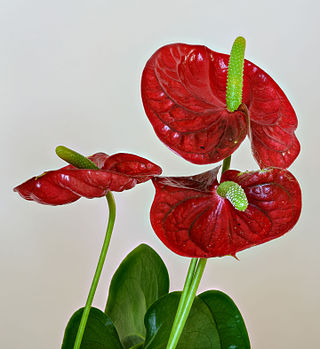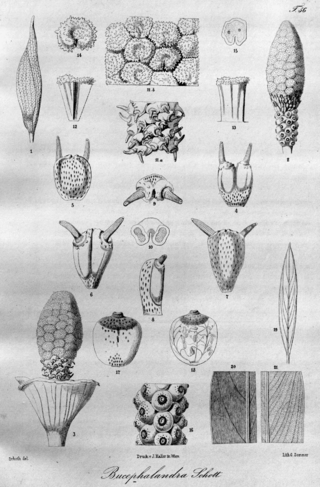
The Alismatales (alismatids) are an order of flowering plants including about 4,500 species. Plants assigned to this order are mostly tropical or aquatic. Some grow in fresh water, some in marine habitats. Perhaps the most important food crop in the order is the taro plant, Colocasia esculenta.

Arales is an order of flowering plants. The name was used in the Cronquist system for an order placed in subclass Arecidae, circumscribed as (1981):

The Araceae are a family of monocotyledonous flowering plants in which flowers are borne on a type of inflorescence called a spadix. The spadix is usually accompanied by, and sometimes partially enclosed in, a spathe. Also known as the arum family, members are often colloquially known as aroids. This family of 140 genera and about 4,075 known species is most diverse in the New World tropics, although also distributed in the Old World tropics and northern temperate regions.

Acorus is a genus of monocot flowering plants. This genus was once placed within the family Araceae (aroids), but more recent classifications place it in its own family Acoraceae and order Acorales, of which it is the sole genus of the oldest surviving line of monocots. Some older studies indicated that it was placed in a lineage, that also includes aroids (Araceae), Tofieldiaceae, and several families of aquatic monocots. However, modern phylogenetic studies demonstrate that Acorus is sister to all other monocots. Common names include calamus and sweet flag.

Cryptocoryne is a genus of aquatic plants from the family Araceae. The genus is naturally distributed in tropical regions of India, Southeast Asia and New Guinea.

Anthurium is a genus of about 1,000 species of flowering plants, the largest genus of the arum family, Araceae. General common names include anthurium, tailflower, flamingo flower, pigtail plant, and laceleaf.

Dracontium is a genus of flowering plants similar to those of Amorphophallus. Unlike Amorphophallus which is found in the Old World, this genus has a New World distribution and is native to South America, Central America, southern Mexico, and the West Indies.

Rhaphidophora is a genus in the family Araceae, occurring from tropical Africa eastwards through Malesia and Australasia to the Western Pacific. The genus consists of approximately 100 species.

Cryptocoryne × willisii is a plant in the family Araceae.
Carlephyton is a genus of four species in the family Araceae, all endemic to Madagascar.

Bucephalandra is a genus of flowering plants in the family Araceae. There are 30 species of Bucephalandra which have been discovered in Borneo and have been formally described by S.Y. Wong and P.C. Boyce. Most of the species are found in Borneo. Bucephalandra are usually found growing as dense mats over stones or rocks in streams or rivers in moist tropical forest.

Stylochaeton is a genus of flowering plants in the family Araceae that is native to Africa. Stylochaeton are rhizomatous with hastate leaves. Flowering in this genus is said to be quite uncommon. Stylochaeton is the sole genus in the tribe Stylochaetoneae.

Lagenandra is a genus of aquatic flowering plants in the aroid family, Araceae, endemic to the Indian Subcontinent. The genus has gradually become more known through the aquascaping and aquarium hobby, in which several related Araceae genera are already highly prized and grown on a large scale ; Lagenandra, however, is still relatively rare in cultivation or private collections.

Hendrik (Henk) Cornelis Dirk de Wit was a Dutch systematic botanist who contributed significantly to the knowledge of the Aroid genera Cryptocoryne and Lagenandra. He grew up in the Waterland, a marshy area in the Northwest Netherlands, and had a lifelong interest in aquatic plants.
Cryptocoryne dewitii is a plant species belonging to the Araceae genus Cryptocoryne. It was first described in 1977 from dried herbarium material and named in honor of the Dutch botanist Hendrik de Wit.

Lagenandra dewitii is an aquatic to semi-aquatic flowering plant species belonging to the aroid genus Lagenandra. It was first described in 1986, from living plants and dried herbarium material, and named in honour of Dutch botanist Hendrik de Wit.

Arie de Graaf is a Dutch insurer, biologist, teacher, and politician.
Begonia bogneri is a species of flowering plant in the family Begoniaceae, native to a single 1 ha locality on the Masoala Peninsula of Madagascar. Uniquely among begonias, it has linear, grass-like leaves. It does well in terrariums.
Cryptocoryne alba is a flowering plant belonging to the genus Cryptocoryne in the family Araceae.















